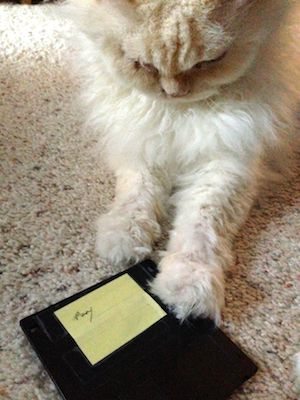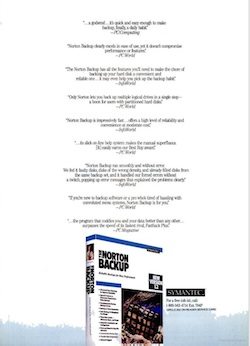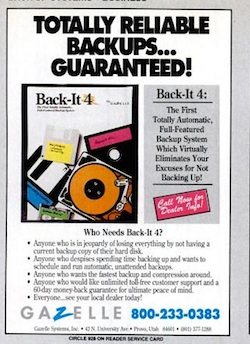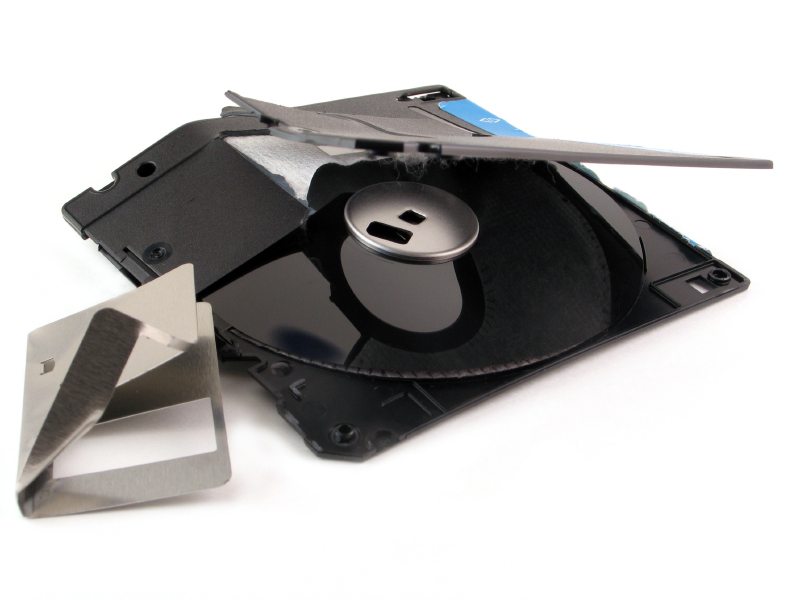“The good old days of personal computing” doesn’t apply to the amount of manual effort required to backup a hard disk. The process of safekeeping our data – using diskettes, the only affordable option for mere mortals – was so arduous that, honestly, few of us actually did it.
Here’s a few nostalgic steps into the painful past to review the history of backing up and to remind us all how much better things are today.
Some things never change – including the need to ensure that the data we accumulate survives physical hardware failures, natural disasters, and the annoying user to whom Tech Support refers as “the 10 fingers of death.” It’s IT’s job to make sure that corporate information is stored safely (which includes being recoverable) whether the business data at risk is sales data, the engineering plans for the company’s next product, or users’ home directories filled with cat videos.
From the earliest days of computing, backup has been defined as “the activity of copying files or databases so that their additional copies may be restored in case of a data loss accident.”
But that makes it sound ever so calm. Ever so easy. A minor task. When in fact, those of us who started early in the personal computer industry remember the backup process as OH GOD WHAT A PAIN MAKE IT STOP MAKE IT STOP. In fact, the only thing worse than backing up a PC was the consequences of not backing up a PC.
There are plenty of technologies that I’m glad are dead – or at least, I’m glad have improved so much. None of them so much as backing up a hard disk… to floppies.
Insert Disk 52…
“Operator error is by far the most common way to lose data. Mis-keyed commands, being in the wrong directory when cleaning off files, and the actions of malicious operators are the prime suspects. All take up valuable time and effort.”

What do I do with this “diskette”? Can I eat it?
So wrote my old friend Stephen Satchell (hi, Satch!) in a 1988 article in InfoWorld, Protecting Your Data From Fire, Flood, and Pestilence. His words are equally true today. (Even today, the top cause of corporate data breaches is inadvertent insider misuse and user error, according to Forrester Research. So the issue remains.)
But in 1988, the effort required for a user to back up a business PC was far more strenuous, because the primary media we used was floppy disks. Sure, you could back up to tape – if you were willing to spend as much money on the tape backup system as you did on a state-of-the-art desktop system, during the heyday of Machrone’s Law.
Enterprise computing (or smart-and-well-off users) might have backed up with a combination of floppy disks, magnetic tape, and telecommunicating information to another system (by which we meant a modem), but even that took more time, was fraught with errors, and you still didn’t trust it. As Satch wrote, “To protect articles like this one, [our reviewer] periodically copies work in progress to one of five floppy disks in a rotating sequence. When the article is substantially complete, he loads the article to InfoWorld’s electronic publishing system. In addition, he backs up his hard disk weekly on a cassette tape storage drive.”
At that time, backing up to floppy disks was time consuming, both in clock time (budget two to three hours) and in hands-on time. That is, you had to sit there and change disks one-at-a-time. To back up a typical 20MB hard disk, you needed 55 (count them, 55 – and you did count them) 360K floppy disks.
The built-in MS-DOS BACKUP program was limited in features; you could select files by name and directory, and that was about it. And it was not forgiving. Find a bad floppy in your box of 55 diskettes? Realize that your disks weren’t pre-formatted when you’re on disk 43? Drop a diskette on the floor, and then roll your desk chair over it? Start all over! Ha ha ha!
And did I mention it was slow? You sat there, steadily feeding one disk after another, losing track of which-disk-was-which (label them? Oh yeah…), and waiting for your brains to drool out of your ears.
Since MS-DOS was single-tasking, you couldn’t even play music or a game in the background. So the backup process was mind-numbing, and it took a few hours out of the workday that, even then, nobody had to spare. Which meant that nobody did their backups, even if they claimed they did.
And I haven’t even mentioned the horrors of trying to restore data from floppies. Which could be complicated by users’ technical understanding which was – let’s be kind – limited. The jokes about people using a refrigerator magnet to keep a backup diskette safe were not made up, I assure you.
An improvement… of sorts
Of course, the weakness of the built-in DOS BACKUP program provided an entrepreneurial opportunity for independent software vendors to sell dedicated backup software. I was so grateful for Norton Backup (which actually told me how many disks I’d need! And estimated how long it’d take! Wow!) that to this day I could be convinced to leave bouquets of flowers at Peter Norton’s house.
 But, as with any new technology, there weren’t many standards. Originally, each backup utility program formatted diskettes in a proprietary format that nothing else could read. I can’t even be funny or snarky about this, because it’s too painful. In the 90s, I knew someone who had dutifully stored his backup floppies off-site; when his business burned to the ground, he figured that at least his data was safe. It was safe – even from himself. He’d been using an older 80s-era backup utility – and he didn’t have a copy of the software which would let him restore the data onto his new computer. Nor, it turned out, did anyone else he knew.
But, as with any new technology, there weren’t many standards. Originally, each backup utility program formatted diskettes in a proprietary format that nothing else could read. I can’t even be funny or snarky about this, because it’s too painful. In the 90s, I knew someone who had dutifully stored his backup floppies off-site; when his business burned to the ground, he figured that at least his data was safe. It was safe – even from himself. He’d been using an older 80s-era backup utility – and he didn’t have a copy of the software which would let him restore the data onto his new computer. Nor, it turned out, did anyone else he knew.
There were certainly plenty of backup utilities to choose from; in 1991, PC Magazine compared 11 of them: Back-It 4, BakupWiz, Central Point Backup, Diskpack, DMS/1B Intelligent Backup, Fastback Plus, SitBack, Sytos Plus File Backup Manager, and TakeTwo Manager. Which, if nothing else, demonstrates that coming up with a clever product name was no easier back then than it is today.
When I owned a computer store in rural Maine, I sold dozens of copies of Fastback (list price $179) which a 1987 PC Magazine article reminded us was no longer copy protected, but reported the utility’s once-innovative features now seemed austere. Because, yes, no matter which backup program you used, you spent time looking at the user interface every time you backed up. There was nothing else to look at. Except the software manuals you didn’t read.
Which is why I sold lots of disk backup software in my store, but most of those boxes never left their shrink wrap. (And yes, I know you youngsters don’t remember what shrink wrap is, either. Damn.)
Information density… and how many floppy drives do you need, now?
Improvements in diskette technology helped – a little bit. The 5¼” floppy disk became the standard once the IBM PC was released, knocking the 8” disks into oblivion; a diskette held 360K of data (barely enough to store a day’s worth of tweets, for me).
 At first, floppy disk drives were only built with one read/write head, but another set of heads were quickly incorporated. When the IBM XT PC arrived in 1983, double-sided floppies could hold up to 360K of data. Over time, the form factor had its technology improved to hold more data; we were grateful for the ability to hold 1.2 megabytes of data—capacious at the time—which became standard with the IBM AT.
At first, floppy disk drives were only built with one read/write head, but another set of heads were quickly incorporated. When the IBM XT PC arrived in 1983, double-sided floppies could hold up to 360K of data. Over time, the form factor had its technology improved to hold more data; we were grateful for the ability to hold 1.2 megabytes of data—capacious at the time—which became standard with the IBM AT.
But there were bumps along the road to PC floppy drive compatibility. Some companies, such as Digital Equipment Corp. with its DEC Rainbow, introduced its own non-compatible 5¼” floppy drives; they were single-sided but with twice the density, and in 1983 a single box of 10 disks cost $45. I remember clearly because I paid this price. Retail. It was painful.
Eventually, the 3½” floppy drives (with rigid plastic jackets) became the mainstay of computing in the 1990s; they dominated the market for the rest of the technology’s life.
But all that meant your average PC needed both a 5¼” floppy drive and a 3½” floppy drive. Because it was a sure thing that the business archive you made last year was on a different diskette format than the one built into your new computer system.
Except, of course, users still didn’t take the time to actually do a backup.
Doesn’t that make you appreciate backup’s ease today?
Some companies are doing the equivalent of backing up on floppy disks, even today, by using external drives and tape. They only back up corporate data periodically, and they rely on end users to take care of it because the process still is a pain.
Today, at least, we have a happy ending. At Druva, we like to think that we’ve made the process of protecting business information about as easy as it can be: Install Druva inSync on company PCs, laptops, and mobile devices, and we take care of the rest. We make it something that you don’t have to think about. And even more important, it’s something that your users don’t have to think about. Because, let’s face it, they aren’t going to do anything to back up their own computers, even if you tell them to – until the day the user says, “My laptop died. Where’s the data?” – and then look stunned when you respond, “Did you back it up?”
Ready to modernize your approach to backup? Download our new report:


